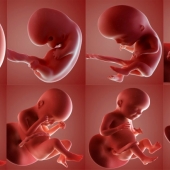What happens in the 35th week of pregnancy? Your baby already might have settled into a head-down position in your pelvis, if this is your first pregnancy. This is the ideal position for delivery because your baby's head is the biggest part of her body.
Your baby in the 35th week of pregnancy:
- At this point your baby drops down to the pelvic area and settles there. And this process is known as lightening
- As your little one settle deeper in your pelvis, this reduces pressure on your rib cage, allowing you more room to expand your diaphragm, but now there may be more pressure on your bladder
- Your baby's height is 18.19 inches and he weighs 5.25 pounds
- By this time your little ones lungs are almost fully developed
- Your baby's pupils now dilate in reaction to light approaching the mother's tummy
- The baby also practices sucking action at this stage, an activity that helps the baby prepare its feeding habits
- By this time the pair of kidneys is fully developed and the liver too is starting to excrete some of the body's waste products
- Your little ones brain is also developing and his/her brain weight increases by almost ten times and by age 12, that same brain will be more than three times the size it was at birth
- As your baby's uterine confines get tighter, her/his movements will feel less like individual kicks and more like slithers and rolls
- Don't be surprised if the contours of your tummy change from time to time it's just your baby's shifting position
Your body in the 35th week of pregnancy:
There’s a good chance that you’re a bit tired of being pregnant by now. Your symptoms remain, including heartburn, swollen ankles, lack of sleep and aches and pains. Rest easy; it’s nearly over. Continue with your visits to the doctor or midwife, and get as much rest as you can.
Your cervix already might begin to dilate or open very slightly to get ready for birth in a few weeks. When this begins, you might notice a sharp pain in your vagina. This doesn't mean you're in labor. Some women begin dilating in the few weeks, days, or even hours before labor. You might continue to feel practice contractions this week. Remember, these contractions will not settle into a regular rhythm.
- 448 views













